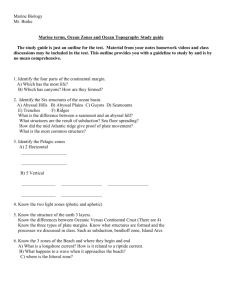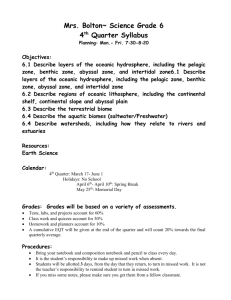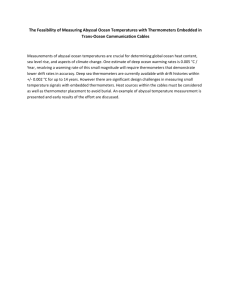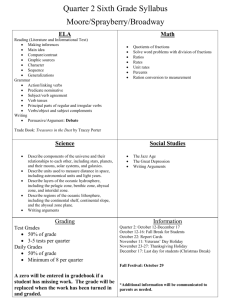Document 14763105
advertisement
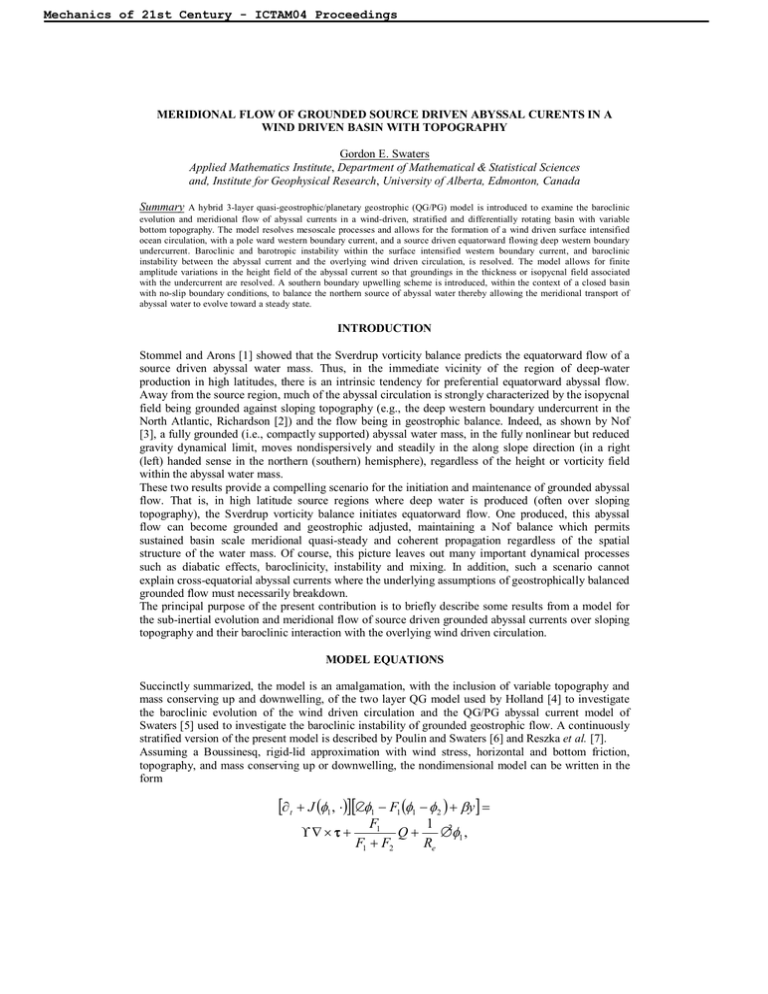
Mechanics of 21st Century - ICTAM04 Proceedings MERIDIONAL FLOW OF GROUNDED SOURCE DRIVEN ABYSSAL CURENTS IN A WIND DRIVEN BASIN WITH TOPOGRAPHY Gordon E. Swaters Applied Mathematics Institute, Department of Mathematical & Statistical Sciences and, Institute for Geophysical Research, University of Alberta, Edmonton, Canada Summary A hybrid 3-layer quasi-geostrophic/planetary geostrophic (QG/PG) model is introduced to examine the baroclinic evolution and meridional flow of abyssal currents in a wind-driven, stratified and differentially rotating basin with variable bottom topography. The model resolves mesoscale processes and allows for the formation of a wind driven surface intensified ocean circulation, with a pole ward western boundary current, and a source driven equatorward flowing deep western boundary undercurrent. Baroclinic and barotropic instability within the surface intensified western boundary current, and baroclinic instability between the abyssal current and the overlying wind driven circulation, is resolved. The model allows for finite amplitude variations in the height field of the abyssal current so that groundings in the thickness or isopycnal field associated with the undercurrent are resolved. A southern boundary upwelling scheme is introduced, within the context of a closed basin with no-slip boundary conditions, to balance the northern source of abyssal water thereby allowing the meridional transport of abyssal water to evolve toward a steady state. INTRODUCTION Stommel and Arons [1] showed that the Sverdrup vorticity balance predicts the equatorward flow of a source driven abyssal water mass. Thus, in the immediate vicinity of the region of deep-water production in high latitudes, there is an intrinsic tendency for preferential equatorward abyssal flow. Away from the source region, much of the abyssal circulation is strongly characterized by the isopycnal field being grounded against sloping topography (e.g., the deep western boundary undercurrent in the North Atlantic, Richardson [2]) and the flow being in geostrophic balance. Indeed, as shown by Nof [3], a fully grounded (i.e., compactly supported) abyssal water mass, in the fully nonlinear but reduced gravity dynamical limit, moves nondispersively and steadily in the along slope direction (in a right (left) handed sense in the northern (southern) hemisphere), regardless of the height or vorticity field within the abyssal water mass. These two results provide a compelling scenario for the initiation and maintenance of grounded abyssal flow. That is, in high latitude source regions where deep water is produced (often over sloping topography), the Sverdrup vorticity balance initiates equatorward flow. One produced, this abyssal flow can become grounded and geostrophic adjusted, maintaining a Nof balance which permits sustained basin scale meridional quasi-steady and coherent propagation regardless of the spatial structure of the water mass. Of course, this picture leaves out many important dynamical processes such as diabatic effects, baroclinicity, instability and mixing. In addition, such a scenario cannot explain cross-equatorial abyssal currents where the underlying assumptions of geostrophically balanced grounded flow must necessarily breakdown. The principal purpose of the present contribution is to briefly describe some results from a model for the sub-inertial evolution and meridional flow of source driven grounded abyssal currents over sloping topography and their baroclinic interaction with the overlying wind driven circulation. MODEL EQUATIONS Succinctly summarized, the model is an amalgamation, with the inclusion of variable topography and mass conserving up and downwelling, of the two layer QG model used by Holland [4] to investigate the baroclinic evolution of the wind driven circulation and the QG/PG abyssal current model of Swaters [5] used to investigate the baroclinic instability of grounded geostrophic flow. A continuously stratified version of the present model is described by Poulin and Swaters [6] and Reszka et al. [7]. Assuming a Boussinesq, rigid-lid approximation with wind stress, horizontal and bottom friction, topography, and mass conserving up or downwelling, the nondimensional model can be written in the form [∂ t + J (φ1 , ⋅)][∆φ1 − F1 (φ1 − φ2 ) + βy ] = ϒ∇× τ + 1 2 F1 Q+ ∆ φ1 , F1 + F2 Re Mechanics of 21st Century - ICTAM04 Proceedings [∂ t + J (φ2 , ⋅)][∆φ2 − F2 (φ2 − φ1 ) + h + hB + βy ] = − r2 ∆φ 2 + ht + F1 1 2 Q+ ∆ φ2 , F1 + F2 Re 1 sβh (φ + h + h ) = J (φ 2 + hB , h ) − 1 + sβy (1 + sβy )2 2 B x Q + r3 ∆(φ 2 + hB + h ), where the notation is standard. The wind stress is explicitly distributed only over the upper layer and the upper layer does not have surface Ekman friction. The upper two layers have horizontal friction, but this has been neglected in the abyssal layer. The abyssal layer does, however, include bottom friction. It can be shown that, in the unforced, inviscid limit, the horizontal divergence of the barotropic mass flux is zero. That is, whatever mass is accumulated into or lost from, say, the abyssal layer, is assumed to have been instantaneously gained from or lost into the upper two layers (where the distribution over the upper two layers is in proportion to the individual upper layer volume fractions). The net barotropic QG mass transport is forced only by wind stress and bottom friction. The unforced, inviscid dynamics of the model is, therefore, purely baroclinic. Though in geostrophic balance, the leading order abyssal layer equations are not geostrophically degenerate and allow for finite amplitude dynamic deflections in the abyssal layer height. The model can be formally derived in a small Rossby number limit of the 3-layer shallow water equations (Swaters [5], Poulin and Swaters [6] and Reszka et al. [7]). There are a number of sub-dynamical, or distinguished, limits in the model which are well known such as the Nof balance describing grounded abyssal flow (Nof [3]), the Stommel-Arons Sverdrup vorticity balance describing the equatorward flow of a source driven abyssal water mass (Stommel and Arons [1]), the planetary shock wave balance (Anderson and Killworth [8] and Dewer [9]) describing the amplitude-beta induced isopycnal steepening associated with the frontal geostrophic dynamical regime (Karsten and Swaters [10]) and, finally, the coupling between the abyssal layer and the overlying ocean which can lead to baroclinic instability and mixing (Swaters [5,11], Poulin and Swaters [6], Reszka et al. [7] and Mooney and Swaters [12]). References [1] Stommel, H. & Arons, A. B., On the abyssal circulation of the world ocean - I. Stationary flow patterns on a sphere. Deep-Sea Res., 6, pp. 140-154, 1960. [2] Richardson, P. L., On the crossover between the Gulf Stream and the Western Boundary Undercurrent. Deep-Sea Res., 24, pp. 139-159, 1977. [3] Nof, D., The translation of isolated cold eddies on a sloping bottom. Deep-Sea Res., 30, pp. 171182, 1983. [4] Holland, W. R., The role of mesoscale eddies in the general circulation of the ocean - Numerical experiments using a wind-driven quasi-geostrophic model. J. Phys. Oceanogr., 8, pp. 363-392, 1978. [5] Swaters, G. E., On the baroclinic instability of cold-core coupled density fronts on sloping continental shelf. J. Fluid Mech., 224, pp. 361-382, 1991. [6] Poulin, F. J. & Swaters, G. E., Sub-inertial dynamics of density-driven flows in a continuously stratified fluid on a sloping bottom. I. Model derivation and stability conditions. Proc. R. Soc. Lond. A, 455, pp. 2281-2304, 1999. [7] Reszka, M. K., Swaters G. E. & Sutherland, B. R., Instability of abyssal currents in a continuously stratified ocean with bottom topography. J. Phys. Oceanogr., 32, pp. 3528-3550, 2002. [8] Anderson, D. & Killworth, P. D., Non-linear propagation of long Rossby waves. Deep-Sea Res., 26, pp. 1033-1050, 1979. [9] Dewer, W. K., Planetary shock waves. J. Phys. Oceanogr., 17, pp. 470-482, 1987. [10] Karsten, R. H. & Swaters, G. E., A unified asymptotic derivation of two-layer, frontal geostrophic models including planetary sphericity and variable topography. Phys. Fluids, 11, pp. 2583-2597, 1999. [11] Swaters, G. E., Numerical simulations of the baroclinic dynamics of density-driven coupled fronts and eddies on a sloping bottom. J. Geophys. Res., 103, pp. 2945-2961, 1998. [12] Mooney, C. J. & Swaters, G. E., Finite amplitude baroclinic instability of a mesoscale gravity current in a channel. Geophys. Astrophys. Fluid Dyn., 82, pp. 173-205, 1996. << session << start
